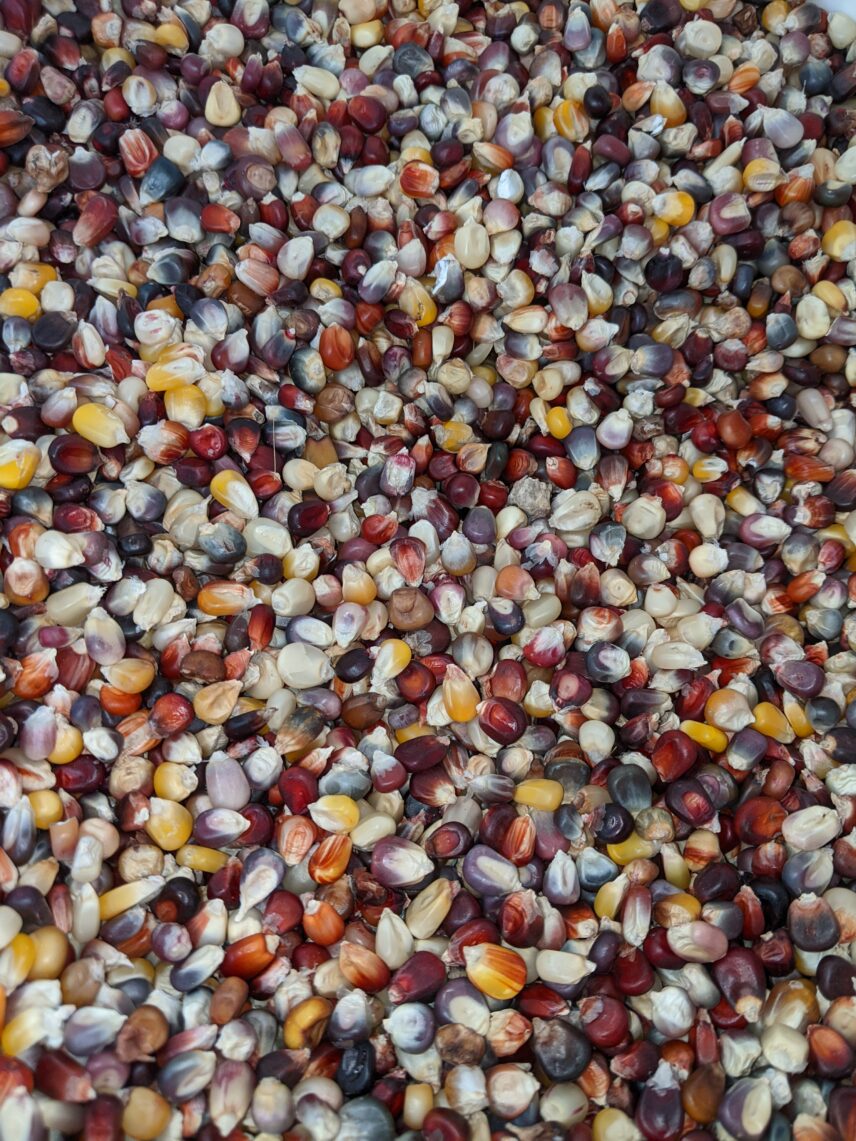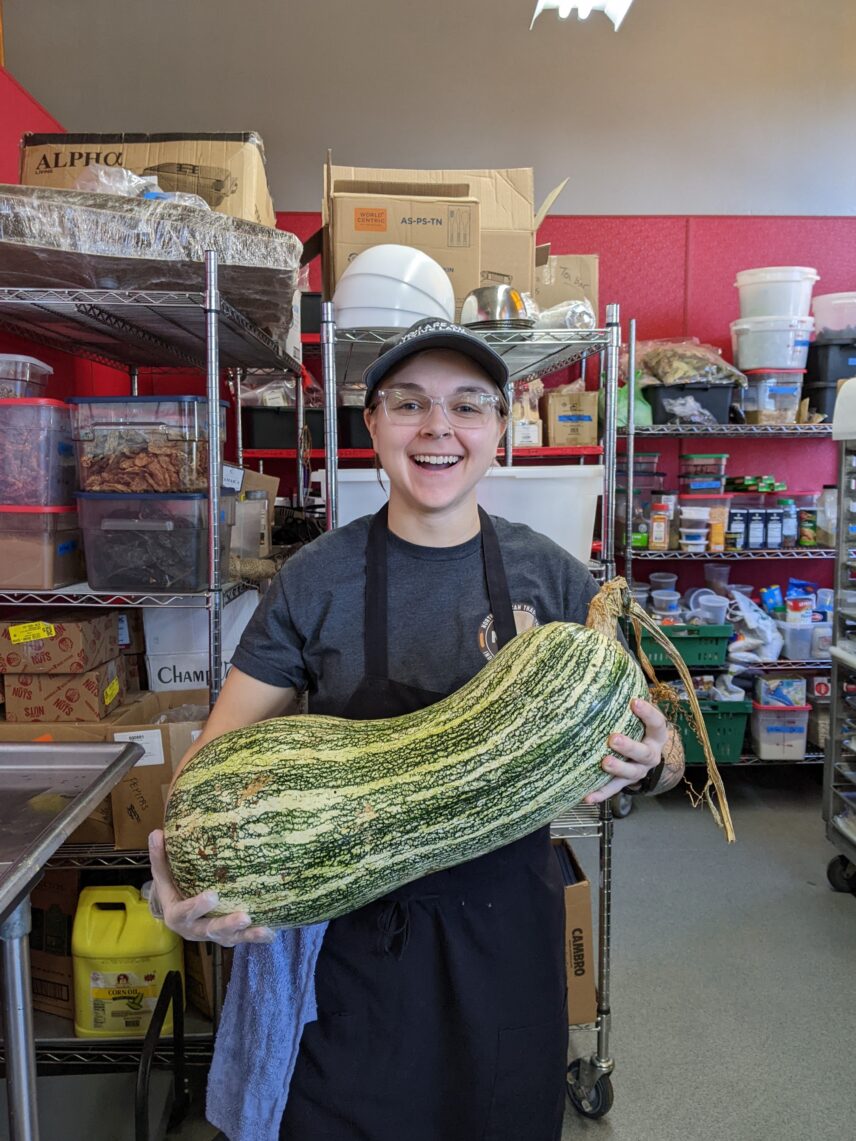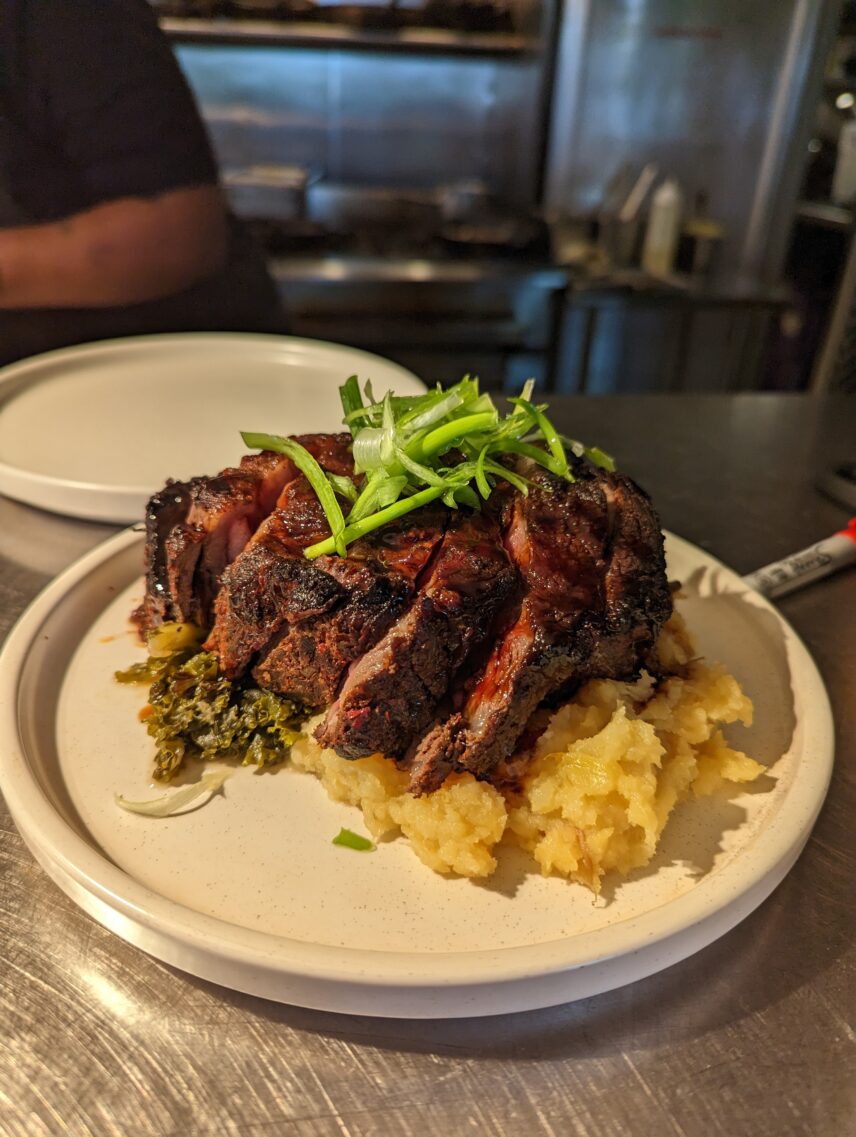Article begins
If you had the opportunity to work at a restaurant where eating savory bites of smoked bison ribeye and maple roast duck was a daily occurrence, would you be compelled to take it? Though the perk of eating amazing food was not my main reason for beginning fieldwork in the restaurant industry, I certainly haven’t minded it.
For over two years, working at Owamni, a James-Beard-award-winning Indigenous restaurant, and NATIFS (North American Traditional Indigenous Food Systems), their partnering culinary nonprofit, has changed not only what I eat but when and how much. At the Minneapolis-based NATIFS nonprofit, lunch is made for staff every day by an elder from Mexico, whom I affectionately think of as the grandmother of the kitchen, not only because she treats me like a member of her family but because both her daughter and granddaughter also work in the nonprofit. She relies on her familiar flavors from Mexican cuisine mixed with the precolonial ingredients we have on hand to make daily meals like bison picadillo or pozole with our own heirloom hominy. With so much tasty and indulgent food available at work, during my first two years in the field, I leaned into my gluttonous side by taking deli container after deli container of leftover delicious staff meals home at the end of my shifts. I relied almost completely on staff meals for those first two years, spurred on by my low-income grad student mentality of “eat anything freely given” and the scarcity mindset that was ingrained in me as a child. With my work at the nonprofit now coming to an end as I begin dissertation writing in earnest, I find myself missing the comforting “home-cooked” meals, but the biggest sense of loss is no longer having the feeling that comes from someone I consider family caring to make a heartfelt meal for me, the joy I see on their face when they know I love and appreciate their labor of love, and the insistent nudging of a grandmother encouraging me to take seconds and a plate home.
If Mexican staples and a communal staff lunch are fixtures at the nonprofit kitchen, then the way I have learned to eat as a staff member of an upscale Indigenous decolonial food restaurant is decidedly different. Owamni describes itself as a “decolonized restaurant experience,” with their core philosophy being to showcase modern Indigenous foods, prioritizing purchasing from Indigenous producers first, followed by local, women, and BIPOC producers. They have “86ed,” or cut from the menu, colonial ingredients such as beef, pork, chicken, dairy, wheat flour, and cane sugar, instead highlighting precolonial products of the Americas, such as corn, beans, squash, wild game, and fish.

At Owamni, there is not a communal staff meal or “family meal” before or in between shifts. Rather, if staff members are hungry during work, we can order one item from the menu to be rung in for the line cooks to prepare. Options must be within reason to be comped, as ordering a whole 16oz bison ribeye or maple glazed half duck for one’s complimentary staff meal would rack up quite an expense for the restaurant. As a result, staff meal options are largely from a cheaper selection of menu items, such as tacos, arepas, or grilled sweet potatoes with chili crisp oil. Another “off-menu” staff meal option is to create a sort of “build your own adventure” bowl where staff can ask for (or sneak onto the line to make their own) personalized bowls that include combinations of prepped line ingredients (wild rice, chili oil, berries, potatoes, duck egg aioli, pulled turkey, beans, braised bison, etc.). I’m a creature of routine, both in terms of what I eat and when. My first few months of working as a line cook, I ate the same open-faced arepa sandwich with pulled turkey, chili oil, duck egg aioli, and mixed vegetables almost every day. I loved that arepa and relied on it so thoroughly that I eventually did make myself sick of it, and yet, I remember that time as a nostalgic one, for it was during our first year of opening when everyone was working long hours and experiencing a collective consciousness of adrenaline and exhaustion.
Continuing to work at the restaurant even up to the present has also altered the time I eat. My meal schedule has very much shifted to accommodate awkwardly timed staff meals (2 p.m. dinners or 4 p.m. lunches) that fall before or after traditional times of eating. When I first started as a line cook working lunch shifts, I always waited until the end of shift, closer to 4 or 5 p.m., to eat lunch so that I could have a proper sit-down, usually tucked away into a corner on a barstool with a bowl balanced on my knees, the strings of my untied black prep apron dangling to the floor. When I transitioned to working front-of-house positions at night, I learned to eat dinner early, around 2:30 p.m., before work so as not to have to stop too long to eat during the dinner rush. Staff are certainly allowed to eat a meal during shifts, and yet, I find it stressful trying to fit in time to eat when I have been taught to always be moving, busing, polishing, re-setting. Always be serving. Eating meals before work ensures that I get a few moments of rest to myself, and despite only now working at the restaurant twice a week, this schedule has impacted me enough to be hungry for dinner around 3 p.m. every day, a reality that my partner has accommodated gracefully, finding it amusing that we eat our lunch and dinner at the same time.

It’s safe to say that after over two years of working at both the restaurant and nonprofit, I’ve begun to miss some of my favorite foods that I haven’t been able to eat as regularly throughout fieldwork. Yet, if the field has changed the way I eat food, it has also changed how desperately I desire to save food and mitigate food waste. Even if I am trying to branch back out to enjoy the foods I’ve missed, when it comes to leftover food at Owamni, I still find myself being the person at the end of shift who is trying to save as much food from the bin as I can by packing it up and passing it along to a roommate, neighbor, friend, or partner. It’s become a personal mission that every extra pound of guajillo-salsa-stewed venison, every last grain of hand-harvested wild rice, every small bit of organic, local, or Indigenous-produced food finds a home. Though folks outside of and within the restaurant industry are trying to be more conscious of and curb food waste, it is still a common and often accepted part of the restaurant industry. Even at a Native food restaurant where food waste is lessened, it very much still happens.
This desire to mitigate food waste is likely influenced by my upbringing, and yet, a new food memory from fieldwork has also influenced me profoundly. Not too long after the restaurant opened in 2021, I remember seeing a coworker meticulously picking every last grain of hand-harvested wild rice out of a pan that had otherwise already been cleaned out by someone else before service. He personally knew the time and labor involved in harvesting wild rice as well as the cultural significance of it, so the thought of letting any go to waste was saddening as well as disrespectful to the rice and ricers. From then on, every wasted grain of rice took on a new meaning for me.

I have loved the food I’ve been fortunate enough to cook and to eat while I’ve been in Minnesota. The thought of myself and other front-of-house staff circling around a plate of “meat snacks,” or scraps of smoked bison steak gifted to us by the line crew, before dunking them barehanded into squash aioli brings a smile to my face even as I write about it. And yet, as many of us food anthropologists can probably relate to, it’s not the food in and of itself that carries the most weight with us out of the field. For me, at least, it’s not the steak. It’s the collective joy of the staff descending upon our meat snacks together like vultures before doing happy dances out the door. It’s not the bison picadillo and pozole. It’s the grandmother who made it for me and the way she, despite largely only speaking Spanish, would repeatedly say in English “I love you. I love you. I love you” as she put a deli container of leftovers in my hands and hugged me tight. And it’s not just the wild rice. It’s about the prep cook who told me his stories of harvesting while we hand-picked discarded grains out of a pan together. This food and this fieldwork have been about them, their stories, and the stories we made together.
Ariana Gunderson is the section contributing editor for the Society for the Anthropology of Food and Nutrition

